Memory Layout for Multiple and Virtual Inheritance
Memory Layout for Multiple and Virtual Inheritance
(By Edsko de Vries, January 2006)
Warning. This article is rather technical and assumes a good knowledge of C++ and some assembly language.
In this article we explain the object layout implemented by gcc for multiple and virtual inheritance.
Although in an ideal world C++ programmers should not need to know these details of the compiler internals,
unfortunately the way multiple (and especially virtual) inheritance is implemented has various non-obvious
consequences for writing C++ code (in particular, for downcasting pointers, using pointers to pointers, and
the invocation order of constructors for virtual bases). If you understand how multiple inheritance is
implemented, you will be able anticipate these consequences and deal with them in your code. Also, it is
useful to understand the cost of using virtual inheritance if you care about efficiency. Finally, it is
interesting :-)
Multiple Inheritance
First we consider the relatively simple case of (non-virtual) multiple inheritance. Consider the following
C++ class hierarchy.
class Top
{p
ublic:
int a;
};
class Left : public Top
{p
ublic:
int b;
};
class Right : public Top
{p
ublic:
int c;
};
class Bottom : public Left, public Right
{p
ublic:
int d;
};
Using a UML diagram, we can represent this hierarchy as

Note that Top is inherited from twice (this is known as repeated inheritance in Eiffel). This means that an
object bottom of type Bottom will have two attributes called a (accessed as bottom.Left::a and
bottom.Right::a).
How are Left, Right and Bottom laid out in memory? We show the simplest case first. Left and Right have the
following structure:
Note that the first attribute is the attribute inherited from Top. This means that after the following two
assignments
Left* left = new Left();
Top* top = left;
left and top can point to the exact same address, and we can treat the Left object as if it were a Top object
(and obviously a similar thing happens for Right). What about Bottom? gcc suggests
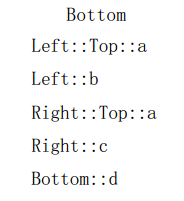
Now what happens when we upcast a Bottom pointer?
Bottom* bottom = new Bottom();
Left* left = bottom;
This works out nicely. Because of the memory layout, we can treat an object of type Bottom as if it were an
object of type Left, because the memory layout of both classes coincide. However, what happens when we upcast
to Right?
Right* right = bottom;
For this to work, we have to adjust the pointer value to make it point to the corresponding section of the
Bottom layout:


After this adjustment, we can access bottom through the right pointer as a normal Right object; however,
bottom and right now point to different memory locations. For completeness' sake, consider what would happen
when we do
Top* top = bottom;
Right, nothing at all. This statement is ambiguous: the compiler will complain
error: `Top' is an ambiguous base of `Bottom'
The two possibilities can be disambiguated using
Top* topL = (Left*) bottom;
Top* topR = (Right*) bottom;
After these two assignments, topL and left will point to the same address, as will topR and right.
Virtual Inheritance
To avoid the repeated inheritance of Top, we must inherit virtually from Top:
class Top
{p
ublic:
int a;
};
class Left : virtual public Top
{p
ublic:
int b;
};
class Right : virtual public Top
{p
ublic:
int c;
};
class Bottom : public Left, public Right
{p
ublic:
int d;
};
This yields the following hierarchy (which is perhaps what you expected in the first place)
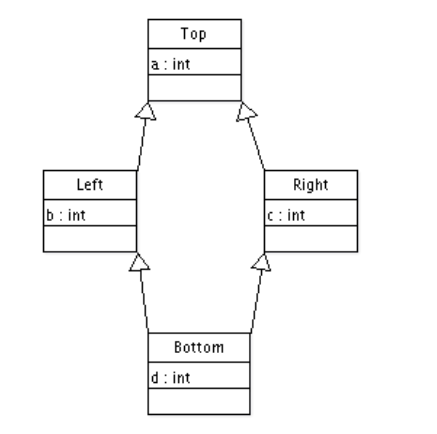
while this may seem more obvious and simpler from a programmer's point of view, from the compiler's point of
view, this is vastly more complicated. Consider the layout of Bottom again. One (non) possibility is

The advantage of this layout is that the first part of the layout collides with the layout of Left, and we
can thus access a Bottom easily through a Left pointer. However, what are we going to do with
Right* right = bottom;
Which address do we assign to right? After this assignment, we should be able to use right as if it were
pointing to a regular Right object. However, this is impossible! The memory layout of Right itself is
completely different, and we can thus no longer access a “real” Right object in the same way as an upcasted
Bottom object. Moreover, no other (simple) layout for Bottom will work.
The solution is non-trivial. We will show the solution first and then explain it.

You should note two things in this diagram. First, the order of the fields is completely different (in fact,
it is approximately the reverse). Second, there are these new vptr pointers. These attributes are
automatically inserted by the compiler when necessary (when using virtual inheritance, or when using virtual
functions). The compiler also inserts code into the constructor to initialise these pointers.
The vptrs (virtual pointers) index a “virtual table”. There is a vptr for every virtual base of the class.
To see how the virtual table (vtable) is used, consider the following C++ code
Bottom* bottom = new Bottom();
Left* left = bottom;
int p = left->a;
The second assignment makes left point to the same address as bottom (i.e., it points to the “top” of the
Bottom object). We consider the compilation of the last assignment (slightly simplified):
movl left, %eax # %eax = left
movl (%eax), %eax # %eax = left.vptr.Left
movl (%eax), %eax # %eax = virtual base offset
addl left, %eax # %eax = left + virtual base offset
movl (%eax), %eax # %eax = left.a
movl %eax, p # p = left.a
In words, we use left to index the virtual table and obtain the “virtual base offset” (vbase). This offset
is then added to left, which is then used to index the Top section of the Bottom object. From the diagram,
you can see that the virtual base offset for Left is 20; if you assume that all the fields in Bottom are 4
bytes, you will see that adding 20 bytes to left will indeed point to the a field.
With this setup, we can access the Right part the same way. After
Bottom* bottom = new Bottom();
Right* right = bottom;
int p = right->a;
right will point to the appropriate part of the Bottom object:

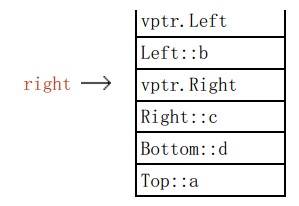
The assignment to p can now be compiled in the exact same way as we did previously for Left. The only
difference is that the vptr we access now points to a different part of the virtual table: the virtual base
offset we obtain is 12, which is correct (verify!). We can summarise this visually:

Of course, the point of the exercise was to be able to access real Right objects the same way as upcasted
Bottom objects. So, we have to introduce vptrs in the layout of Right (and Left) too:

Now we can access a Bottom object through a Right pointer without further difficulty. However, this has come
at rather large expense: we needed to introduce virtual tables, classes needed to be extended with one or
more virtual pointers, and a simple attribute lookup in an object now needs two indirections through the
virtual table (although compiler optimizations can reduce that cost somewhat).
Downcasting
As we have seen, casting a pointer of type DerivedClass to a pointer of type SuperClass (in other words,
upcasting) may involve adding an offset to the pointer. One might be tempted to think that downcasting (going
the other way) can then simply be implemented by subtracting the same offset. And indeed, this is the case
for non-virtual inheritance. However, virtual inheritance (unsurprisingly!) introduces another complication.
Suppose we extend our inheritance hierarchy with the following class.
class AnotherBottom : public Left, public Right
{p
ublic:
int e;
int f;
};
The hierarchy now looks like

Now consider the following code.
Bottom* bottom1 = new Bottom();
AnotherBottom* bottom2 = new AnotherBottom();
Top* top1 = bottom1;
Top* top2 = bottom2;
Left* left = static_cast<Left*>(top1);
The following diagram shows the layout of Bottom and AnotherBottom, and shows where top is pointing after the
last assignment.
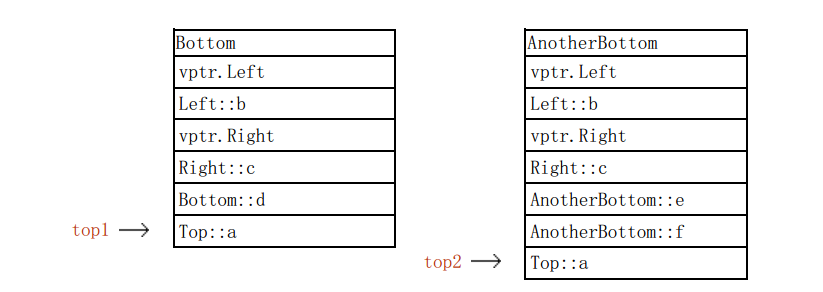
Now consider how to implement the static cast from top1 to left, while taking into account that we do not
know whether top1 is pointing to an object of type Bottom or an object of type AnotherBottom. It can't be
done! The necessary offset depends on the runtime type of top1 (20 for Bottom and 24 for AnotherBottom). The
compiler will complain:
error: cannot convert from base `Top' to derived type `Left'
via virtual base `Top'
Since we need runtime information, we need to use a dynamic cast instead:
Left* left = dynamic_cast<Left*>(top1);
However, the compiler is still unhappy:
error: cannot dynamic_cast `top' (of type `class Top*') to type
`class Left*' (source type is not polymorphic)
The problem is that a dynamic cast (as well as use of typeid) needs runtime type information about the object
pointed to by top1. However, if you look at the diagram, you will see that all we have at the location
pointed to by top1 is an integer (a). The compiler did not include a vptr.Top because it did not think that
was necessary. To force the compiler to include this vptr, we can add a virtual destructor to Top:
class Top
{
public:
virtual ~Top() {}
int a;
};
This change necessitates a vptr for Top. The new layout for Bottom is
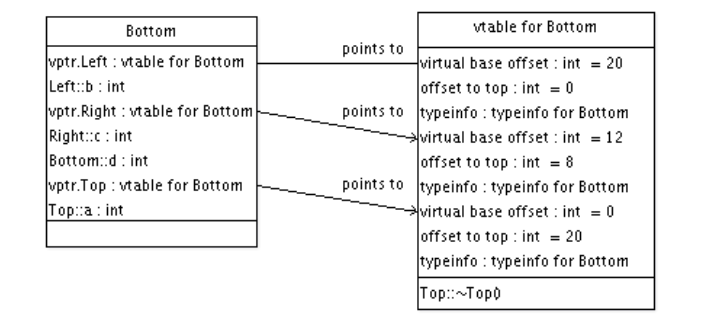
(Of course, the other classes get a similar new vptr.Top attribute). The compiler now inserts a library call
for the dynamic cast:
left = __dynamic_cast(top1, typeinfo_for_Top, typeinfo_for_Left, -);
This function __dynamic_cast is defined in libstdc++ (the corresponding header file is cxxabi.h); armed with
the type information for Top, Left and Bottom (through vptr.Top), the cast can be executed. (The -1 parameter
indicates that the relationship between Left and Top is presently unknown). For details, refer to the
implementation in tinfo.cc.
Concluding Remarks
Finally, we tie a couple of loose ends.
(In)variance of Double Pointers
This is were it gets slightly confusing, although it is rather obvious when you give it some thought. We
consider an example. Assume the class hierarchy presented in the last section (Downcasting). We have seen
previously what the effect is of
Bottom* b = new Bottom();
Right* r = b;
(the value of b gets adjusted by 8 bytes before it is assigned to r, so that it points to the Right section
of the Bottom object). Thus, we can legally assign a Bottom* to a Right*. What about Bottom** and Right**?
Bottom** bb = &b;
Right** rr = bb;
Should the compiler accept this? A quick test will show that the compiler will complain:
error: invalid conversion from `Bottom**' to `Right**'
Why? Suppose the compiler would accept the assignment of bb to rr. We can visualise the result as:

So, bb and rr both point to b, and b and r point to the appropriate sections of the Bottom object. Now consider what happens when we assign to *rr (note that the type of *rr is Right*, so this assignment is
valid):
*rr = b;
This is essentially the same assignment as the assignment to r above. Thus, the compiler will implement it
the same way! In particular, it will adjust the value of b by 8 bytes before it assigns it to *rr. But *rr
pointed to b! If we visualise the result again:
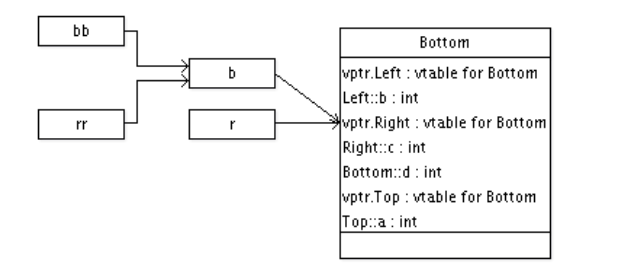
This is correct as long as we access the Bottom object through *rr, but as soon as we access it through b
itself, all memory references will be off by 8 bytes — obviously a very undesirable situation.
So, in summary, even if *a and *b are related by some subtyping relation, **a and **b are not.
Constructors of Virtual Bases
The compiler must guarantee that all virtual pointers of an object are properly initialised. In particular,
it guarantees that the constructor for all virtual bases of a class get invoked, and get invoked only once.
If you don't explicitly call the constructors of your virtual superclasses (independent of how far up the
tree they are), the compiler will automatically insert a call to their default constructors.
This can lead to some unexpected results. Consider the same class hierarchy again we have been considering so
far, extended with constructors:
class Top
{p
ublic:
Top() { a = -; }
Top(int _a) { a = _a; }
int a;
};
class Left : public Top
{p
ublic:
Left() { b = -; }
Left(int _a, int _b) : Top(_a) { b = _b; }
int b;
};
class Right : public Top
{p
ublic:
Right() { c = -; }
Right(int _a, int _c) : Top(_a) { c = _c; }
int c;
};
class Bottom : public Left, public Right
{p
ublic:
Bottom() { d = -; }
Bottom(int _a, int _b, int _c, int _d) : Left(_a, _b), Right(_a, _c)
{
d = _d;
}
int d;
};
(We consider the non-virtual case first.) What would you expect this to output:
Bottom bottom(,,,);
printf("%d %d %d %d %d\n", bottom.Left::a, bottom.Right::a,
bottom.b, bottom.c, bottom.d);
You would probably expect (and get)
However, now consider the virtual case (where we inherit virtually from Top). If we make that single change,
and run the program again, we instead get
- -
Why? If you trace the execution of the constructors, you will find
Top::Top()
Left::Left(,)
Right::Right(,)
Bottom::Bottom(,,,)
As explained above, the compiler has inserted a call to the default constructor in Bottom, before the
execution of the other constructors. Then when Left tries to call its superconstructor (Top), we find that
Top has already been initialised and the constructor does not get invoked.
To avoid this situation, you should explicitly call the constructor of your virtual base(s):
Bottom(int _a, int _b, int _c, int _d): Top(_a), Left(_a,_b), Right(_a,_c)
{
d = _d;
}
Pointer Equivalence
Once again assuming the same (virtual) class hierarchy, would you expect this to print “Equal”?
Bottom* b = new Bottom();
Right* r = b;
if(r == b)
printf("Equal!\n");
Bear in mind that the two addresses are not actually equal (r is off by 8 bytes). However, that should be
completely transparent to the user; so, the compiler actually subtracts the 8 bytes from r before comparing
it to b; thus, the two addresses are considered equal.
Casting to void*
Finally, we consider what happens we can cast an object to void*. The compiler must guarantee that a pointer
cast to void* points to the “top” of the object. Using the vtable, this is actually very easy to implement.
You may have been wondering what the offset to top field is. It is the offset from the vptr to the top of the
object. So, a cast to void* can be implemented using a single lookup in the vtable. Make sure to use a
dynamic cast, however, thus:
dynamic_cast<void*>(b);
Memory Layout for Multiple and Virtual Inheritance的更多相关文章
- Memory Layout (Virtual address space of a C process)
Memory Layout (Virtual address space of a C process) 分类: C语言基础2012-12-06 23:16 2174人阅读 评论(0) 收藏 举报 f ...
- Kernel Memory Layout on ARM Linux
这是内核自带的文档,讲解ARM芯片的内存是如何布局的!比较简单,对于初学者可以看一下!但要想深入理解Linux内存管理,建议还是找几本好书看看,如深入理解Linux虚拟内存,嵌入系统分析,Linux内 ...
- Memory Layout of C Programs
Memory Layout of C Programs A typical memory representation of C program consists of following sec ...
- 【ARM-Linux开发】Linux内存管理:ARM Memory Layout以及mmu配置
原文:Linux内存管理:ARM Memory Layout以及mmu配置 在内核进行page初始化以及mmu配置之前,首先需要知道整个memory map. 1. ARM Memory Layout ...
- C++: virtual inheritance and Cross Delegation
Link1: Give an example Note: I think the Storable::Write method should also be pure virtual. http:// ...
- Use Memory Layout from Target Dialog Scatter File
参考 MDK-ARM Linker Scatter File的用法(转载) keil报错 Rebuild target 'Target 1' assembling test1.s... linking ...
- PatentTips - Method to manage memory in a platform with virtual machines
BACKGROUND INFORMATION Various mechanisms exist for managing memory in a virtual machine environment ...
- System and method for parallel execution of memory transactions using multiple memory models, including SSO, TSO, PSO and RMO
A data processor supports the use of multiple memory models by computer programs. At a device extern ...
- [译]rabbitmq 2.4 Multiple tenants: virtual hosts and separation
我对rabbitmq学习还不深入,这些翻译仅仅做资料保存,希望不要误导大家. With exchanges, bindings, and queues under your belt, you mig ...
随机推荐
- MAC MAMP 中安装配置使用 ThinkPHP
MAMP PRO 是Mac OS X 平台上经典的本地环境应用 MAMP 的专业版.专门为专业的Web开发人员和程序员轻松地安装和管理自己的开发环境. MAMP这几个首字母代表Mac OS X系统上的 ...
- shell脚本批量ssh登陆主机并执行命令
shell脚本批量ssh登陆主机并执行命令 今天在客户现场遇到了这个问题,客户没有管理工具,无法批量登陆主机下发命令,几个个C段啊,让我一个一个登陆,.................. 所以写了个s ...
- 20181112-PostgreSQL数据库dmp文件导入(记录一次数据导入)
20181112-PostgreSQL数据库dmp文件导入 标注:dmp文件导入,场景:多个schema导入 1. 环境准备: postgres集群master节点上,postgres用户执行以下操作 ...
- C 存储类
存储类定义 C 程序中变量/函数的范围(可见性)和生命周期.这些说明符放置在它们所修饰的类型之前.下面列出 C 程序中可用的存储类: auto.register.static.extern auto ...
- ansible学习(二)
什么是YAML? YAML是一种标记语言.适合用来表达层次结构式的数据结构. YAML的基本组件:清单(短杠——空白字符)和散列表(短杠+空白字符分隔key:value对). Playbook的核心元 ...
- Boosting Static Representation Robustness for Binary Clone Search against Code Obfuscation and Compiler Optimization(一)
接着上一篇,现在明确问题:在汇编克隆搜索文献中,有四种类型的克隆[15][16][17]:Type1.literally identical(字面相同):Type2.syntactically equ ...
- eclipse 中 git 解决冲突(重点)
Eclipse 中 GIT 提交代码时的冲突困扰了我很久,说实在的,真的感觉 GIT 太特么难用了,尤其是提交代码时(或许还没习惯吧).特此,写一篇博文记录一下自己使用 GIT 决解冲突的问题,希望能 ...
- HBase Client JAVA API
旧 的 HBase 接口逻辑与传统 JDBC 方式很不相同,新的接口与传统 JDBC 的逻辑更加相像,具有更加清晰的 Connection 管理方式. 同时,在旧的接口中,客户端何时将 Put 写到服 ...
- HBase 数据模型
在HBase中,数据是存储在有行有列的表格中.这是与关系型数据库重复的术语,并不是有用的类比.相反,HBase可以被认为是一个多维度的映射. HBase数据模型术语 Table(表格) 一个HBase ...
- kernel笔记——网络收发包流程
本文将介绍网络连接建立的过程.收发包流程,以及其中应用层.tcp层.ip层.设备层和驱动层各层发挥的作用. 应用层 对于使用socket进行网络连接的服务器端程序,我们会先调用socket函数创建一个 ...
